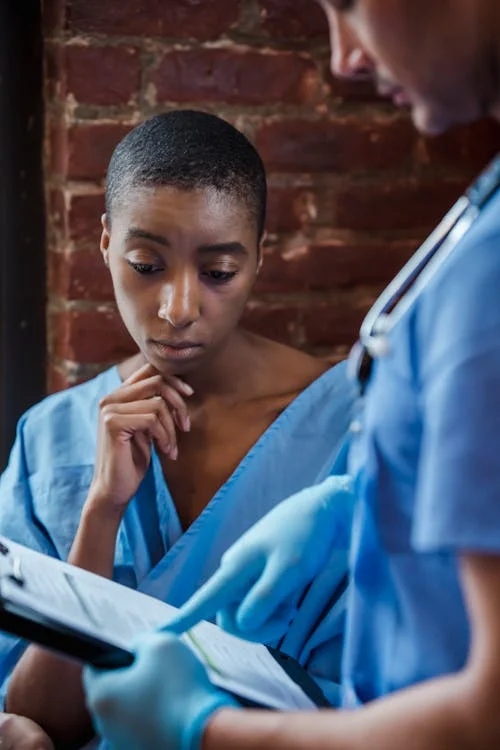Endometriosis, Self-Advocacy & Us
- esther9796
- Mar 27, 2024
- 6 min read
Updated: Apr 12, 2024
March is endometriosis awareness month. In the UK, endometriosis affects 1 in 10 reproductive-aged women and people assigned female at birth, making it the second most common gynaecological condition in the country (1,2). Endometriosis also affects over 176 million people around the world. Although so many people suffer from endometriosis, there is still so much we do not know about it, and getting a diagnosis, especially as a Black woman can be difficult. In this post, we learn more about endometriosis and advocating for yourself in a healthcare setting.
What do we know about endometriosis?
Endometriosis is a long-term condition where tissue similar to the lining of the uterus (endometrium) is found outside of the uterus. Endometriosis can be classified into 3 subtypes depending on where in the body the endometrial tissue is found (3). The 3 subtypes are:
Superficial endometriosis, where endometrial tissue is found on the surface or in the soft tissue (upper layers) of the peritoneum or organs such as the uterus, lungs, bladder, and bowels
Deep infiltrating endometriosis (DIE), where endometrial tissue is found in the muscular layer of organs such as the intestine, bladder wall, and diaphragm
Ovarian endometriotic cysts (OEC), where endometrial tissue forms cysts (known as known as endometriomas or chocolate cysts) in and on the ovaries
Symptoms of endometriosis include painful periods, pelvic pain, pain during or after sex, infertility, and pain while passing urine and bowel movements (2). For some people, dealing with endometriosis can also lead to depression. Each subtype of endometriosis is associated with different symptoms of the condition. People with DIE tend to experience gastrointestinal issues and high levels of pain while people with OEC commonly experience infertility (3). The OEC subtype of endometriosis has also been linked to a 50% increase in the risk of developing ovarian cancer (4).
Unfortunately, the cause of endometriosis is still unknown. What we do know is that endometriosis is not contagious and is not considered to be the result of an infection (2). Endometriosis can affect anyone with a uterus in the reproductive period of their life, however, most people start to experience symptoms between ages 25 and 35 (4). While there is no known cure for endometriosis, there are ways to help treat the symptoms such as laparoscopic surgery to remove endometriotic tissue, and symptoms usually improve with the onset of menopause (2,4). You can find out more about other treatments for endometriosis in one of our older blog posts, here, and on the NHS website.
How do we know if we have endometriosis?
There are 4 main tools that are used to diagnose endometriosis (2).
Going through your medical history with your doctor could help to highlight symptoms of endometriosis
A pelvic examination could help identify ovarian cysts and endometriotic tissue around the uterus, bowels, and vagina
An ultrasound scan can help to determine how much endometriotic tissue there is which indicates how severe the condition is. This can be helpful when planning treatments.
A laparoscopy procedure to look for endometriotic tissue inside the abdomen and pelvis. This is a surgical procedure usually done by a gynaecologist (a specialist doctor) that involves inserting a telescope through a small cut in the navel (near your belly button). A laparoscopy is generally considered the most reliable way to diagnose endometriosis.
To get an endometriosis diagnosis, many people use all of the tools mentioned above. This can be a long and difficult process and many people experience large delays throughout. On average, those experiencing symptoms can be left waiting for up to 8 years from the onset of their symptoms before receiving a diagnosis (5). Reasons for this may vary, from lack of resources to clinician bias.
Unfortunately, it can be difficult to have your reproductive health concerns taken seriously in a healthcare setting. There are countless stories out there of women or people with uteruses who have not been taken seriously and have faced serious and sometimes fatal consequences as a result. Bias like this can be extra harmful to Black women. Implicit racial bias can often mean that Black people receive less than optimal care resulting in poorer outcomes (6,7). One 2016 study on racial bias in pain assessment and treatment found that around 50% of White people, medical students, and resident doctors held at least one false belief about biological differences between Black and White people (for example, Black people have less sensitive nerve endings than White people, suggesting that we feel less pain) (8). A systematic review of the prevalence of endometriosis found that Black people are almost 50% less likely to receive an endometriosis diagnosis compared to White people (9). This statistic may not necessarily mean that Black women are less likely to develop endometriosis, but rather it could be a result of the combined effects of racial bias and sexism (6).
How do we make sure we’re taken seriously?
Advocating for yourself and your health can take a lot of courage, especially in the face of institutional problems like racism and sexism. Here are a few things you can do to help make sure that your concerns are taken seriously:
Tip 1: Keep a record of your symptoms
It can help to document your symptoms to show your doctor. For endometriosis, Endometriosis UK have developed a pain and symptoms diary that you can find here, to help track the onset and severity of your symptoms. This can help to back you up when you seek medical assistance and even be used as evidence for applications for benefits if your symptoms prevent you from working or going to school/university.
Tip 2: Bring a chaperone to your appointments
It might also be helpful to take someone you trust along with you to your appointments who can help to confirm what you are saying and help keep track of the outcome of your visits. Your person (chaperone) could be a parent/guardian, a sibling, or even a close friend. Having a chaperone is fairly common, many people attend appointments with someone else for support and some hospital trusts even recommend it. If you would prefer not to have a friend or family member with you but would still like someone there to support you, many hospitals offer a chaperone service. This chaperone will be another healthcare professional who acts as an objective third party to help make sure that there are no misunderstandings between you and your doctor/clinician. You can read more about some of the responsibilities of a hospital-provided chaperone here.
Tip 3: Ask your doctor to document their reasoning
If you believe that your doctor is not taking your concerns seriously, it may be useful to ask them to document the reasons behind their recommendations. This can help you if you want to take your concerns to another doctor or even provide evidence if you want to make an official complaint to the Patient Advice and Liaison Service (PALS). You can find out more about how PALS can help and about the process of making a complaint here.
These tips can be helpful for other conditions as well, especially ones that disproportionately affect Black people like sickle cell anaemia (10). Making sure that your healthcare provider takes your concerns seriously can help to make sure that you get the treatment you need at the right time. These tips are in no way exhaustive. If you have any more ideas on how to better advocate for yourself and your healthcare, please don’t hesitate to share them with us.
It is extremely unfortunate that getting help from a clinician as a Black woman may need this extra layer of vigilance. Hopefully, one day, we won’t have to worry about making sure that we are believed when we ask for help. Until then, we can support each other to make sure that our voices are heard.
By Esther Ansah, Blog Writer
References
1. Rogers PAW, D’Hooghe TM, Fazleabas A, Gargett CE, Giudice LC, Montgomery GW, et al. Priorities for endometriosis research: recommendations from an international consensus workshop. Reprod Sci. 2009 Apr;16(4):335–46.
2. General information about Endometriosis : University College London Hospitals NHS Foundation Trust. https://www.uclh.nhs.uk/our-services/find-service/womens-health-1/gynaecology/endometriosis/general-information-about-endometriosis
3. Wang Y, Nicholes K, Shih IM. The Origin and Pathogenesis of Endometriosis. Annual Review of Pathology: Mechanisms of Disease. 2020 Jan 24;15(Volume 15, 2020):71–95.
4. Vercellini P, Viganò P, Somigliana E, Fedele L. Endometriosis: pathogenesis and treatment. Nature Reviews Endocrinology 2013 10:5. 2013 Dec 24;10(5):261–75.
5. Arruda MS, Petta CA, Abrão MS, Benetti-Pinto CL. Time elapsed from onset of symptoms to diagnosis of endometriosis in a cohort study of Brazilian women. Human Reproduction. 2003 Apr 1;18(4):756–9.
6. Washington A, Randall J. “We’re Not Taken Seriously”: Describing the Experiences of Perceived Discrimination in Medical Settings for Black Women. J Racial Ethn Health Disparities. 2023 Apr 1;10(2):883–91.
7. Danso A, Danso Y. The complexities of race and health. Future Healthc J. 2021 Mar;8(1):22.
8. Hoffman KM, Trawalter S, Axt JR, Oliver MN. Racial bias in pain assessment and treatment recommendations, and false beliefs about biological differences between blacks and whites. Proc Natl Acad Sci U S A. 2016 Apr 19;113(16):4296–301.
9. Bougie O, Yap MI, Sikora L, Flaxman T, Singh S. Influence of race/ethnicity on prevalence and presentation of endometriosis: a systematic review and meta-analysis. BJOG. 2019 Aug 1;126(9):1104–15.
10. Cullen MR, Lemeshow AR, Russo LJ, Barnes DM, Ababio Y, Habtezion A. Disease-Specific Health Disparities: A Targeted Review Focusing on Race and Ethnicity. Healthcare 2022, Vol 10, Page 603. 2022 Mar 23;10(4):603.











Comments